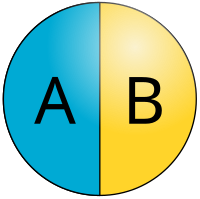
Formation of Phospholipid Association Colloids in Rapeseed Oil and Their Effect on Lipid Autoxidation in the Presence of Sinapic and Ferulic Acid
Sign Up to like & getrecommendations! Published in 2019 at "European Journal of Lipid Science and Technology"
DOI: 10.1002/ejlt.201900243
Abstract: This study describes the formation of 1,2‐dioleoyl‐sn‐glycero‐3‐phosphocholine (DOPC) association colloids (reverse micelles) in rapeseed oil and interactions of sinapic and ferulic acids with these structures. Furthermore, the process of oil autoxidation in the presence of… read more here.
Keywords: rapeseed oil; presence; formation; oil ... See more keywords

Determination of the Water/AOT/Isooctane Reverse Micelles Size Parameters from Their Refractive Index Data
Sign Up to like & getrecommendations! Published in 2017 at "Journal of Solution Chemistry"
DOI: 10.1007/s10953-016-0563-x
Abstract: The present paper aims to study the proprieties of water confined in water/AOT/isooctane reverse micelles from their refractive indices at 298.5 K. The refractive indices of the microemulsions were investigated at increasing water concentration and at… read more here.
Keywords: water aot; water; reverse micelles; refractive index ... See more keywords

Self – assembly of model surfactants as reverse micelles in nonpolar solvents and their role as interfacial tension modifiers
Sign Up to like & getrecommendations! Published in 2021 at "Colloids and Surfaces A: Physicochemical and Engineering Aspects"
DOI: 10.1016/j.colsurfa.2021.126244
Abstract: Abstract The self-assembly of linear surfactants into reverse micelles (RMs) in nonpolar solvents, and their efficiency in reducing the interfacial tension is studied using dissipative particle dynamic simulations. Given the importance of RMs as thickeners,… read more here.
Keywords: self assembly; interfacial tension; surfactants reverse; tension ... See more keywords

Imim-DEHP reverse micelles investigated with two molecular probes reveals how are the interfacial properties and the coordination behavior of the surfactant
Sign Up to like & getrecommendations! Published in 2020 at "Journal of Molecular Liquids"
DOI: 10.1016/j.molliq.2020.113592
Abstract: Abstract Aqueous reverse micelles (RMs) generated with the ionic liquid (IL)-surfactant 1-methylimidazolium bis-(2-ethylhexyl)phosphate (imim-DEHP) and the biocompatible solvents methyl laurate (ML) and isopropyl myristate (IPM) were studied through the use of two molecular probes: the… read more here.
Keywords: dehp; two molecular; imim dehp; molecular probes ... See more keywords

How mobile is the water in the reverse micelles? A 2DIR study with an ultrasmall IR probe
Sign Up to like & getrecommendations! Published in 2020 at "Journal of Molecular Liquids"
DOI: 10.1016/j.molliq.2020.114819
Abstract: Abstract Water molecules in reverse micelle serve as an excellent model for biological water. However, it has been argued previously that water molecules at the centre, even for smaller sized water pools of reverse micelles,… read more here.
Keywords: probe; water; water pool; vibrational lifetime ... See more keywords

Laser diagnostics of reverse microemulsions: Influence of the size and shape of reverse micelles on the Raman spectrum on the example of water/AOT/cyclohexane system
Sign Up to like & getrecommendations! Published in 2021 at "Journal of Molecular Liquids"
DOI: 10.1016/j.molliq.2020.115153
Abstract: Abstract In this study, the influence of the size and shape of reverse micelles in water/AOT-Na/cyclohexane microemulsions on the spectral characteristics of vibrational spectra was studied using Raman laser spectroscopy and method of dynamic light… read more here.
Keywords: water; size; influence size; size shape ... See more keywords

Ascorbyl radical disproportionation in reverse micellar systems
Sign Up to like & getrecommendations! Published in 2017 at "Radiation Physics and Chemistry"
DOI: 10.1016/j.radphyschem.2017.10.019
Abstract: Abstract Ascorbyl radical was generated by the pulse radiolysis method and observed with the fast kinetic spectrophotometry within reverse micelles stabilized by AOT in n-heptane or by Igepal CO-520 in cyclohexane at different water to… read more here.
Keywords: ascorbyl radical; reverse micellar; reverse; aot heptane ... See more keywords

Ultrafast Fluorescence Dynamics of Highly Stable Copper Nanoclusters Synthesized inside the Aqueous Nanopool of Reverse Micelles
Sign Up to like & getrecommendations! Published in 2018 at "Journal of Physical Chemistry C"
DOI: 10.1021/acs.jpcc.7b11457
Abstract: Herein, we have reported a new strategy for the synthesis of highly stable fluorescent copper nanoclusters (CuNCs) with l-cysteine (Cys) as a protecting ligand within the water nanopool of reverse micelles (RMs). In the present… read more here.
Keywords: surface states; fluorescence; nanopool reverse; copper nanoclusters ... See more keywords

An alternative to the conventional dilution method using temperature changes to stabilize/destabilize reverse micelles containing cosurfactant
Sign Up to like & getrecommendations! Published in 2021 at "Journal of Dispersion Science and Technology"
DOI: 10.1080/01932691.2021.1949340
Abstract: An alternative to the conventional dilution method (CDM) to characterize reverse micelles (RMs) containing cosurfactant is presented. This method can be performed following two routes: (i) adding o... read more here.
Keywords: reverse micelles; alternative conventional; dilution method; method ... See more keywords

Synthesis of submicron-sized CdS particles using reverse micelles
Sign Up to like & getrecommendations! Published in 2020 at "Journal of Nanophotonics"
DOI: 10.1117/1.jnp.14.026013
Abstract: Abstract. We synthesized cadmium sulfide (CdS) submicron particles in reverse micelles. We chose the surfactants and the water-to-surfactant molar ratio to influence the formation of reverse micelles such that their average size was 100 nm.… read more here.
Keywords: reverse; synthesis submicron; reverse micelles; submicron sized ... See more keywords

Size Distribution and Characteristics of Chitin Microgels Prepared via Emulsified Reverse-Micelles
Sign Up to like & getrecommendations! Published in 2019 at "Materials"
DOI: 10.3390/ma12071160
Abstract: Chitin was extracted from local snow crab shell waste and used as a raw material in the fabrication of porous spherical microgels. The chitin microgels were obtained using a batch process of emulsification and, afterward,… read more here.
Keywords: chitin microgels; size distribution; emulsified reverse; size ... See more keywords